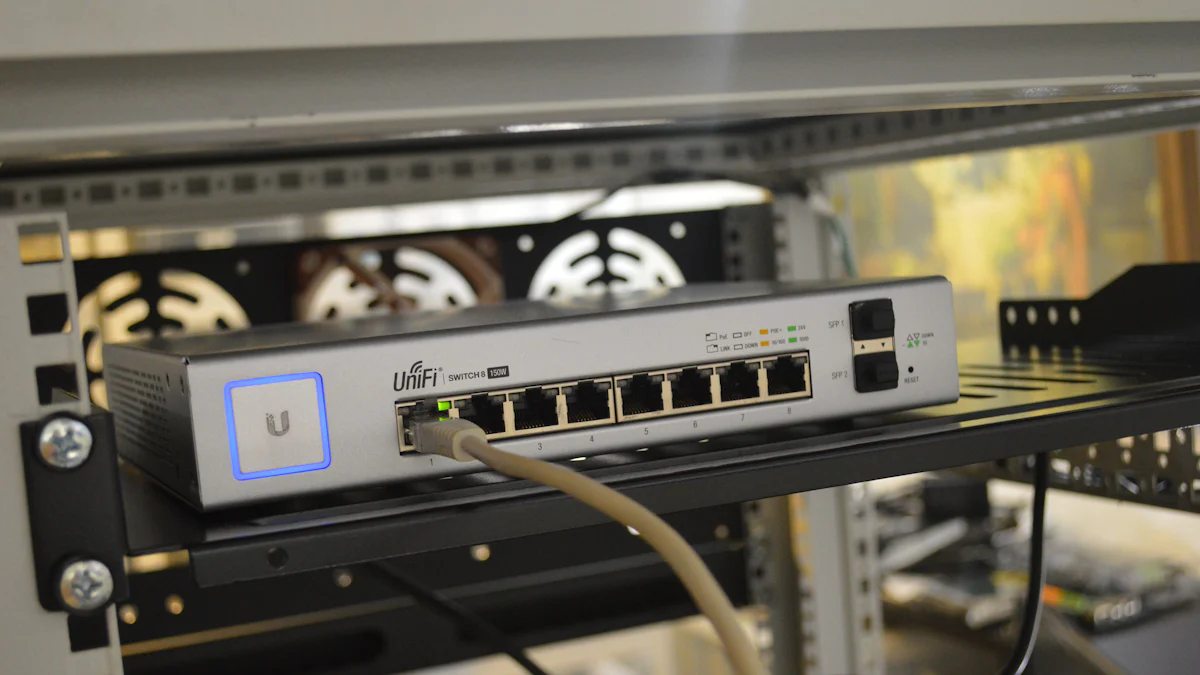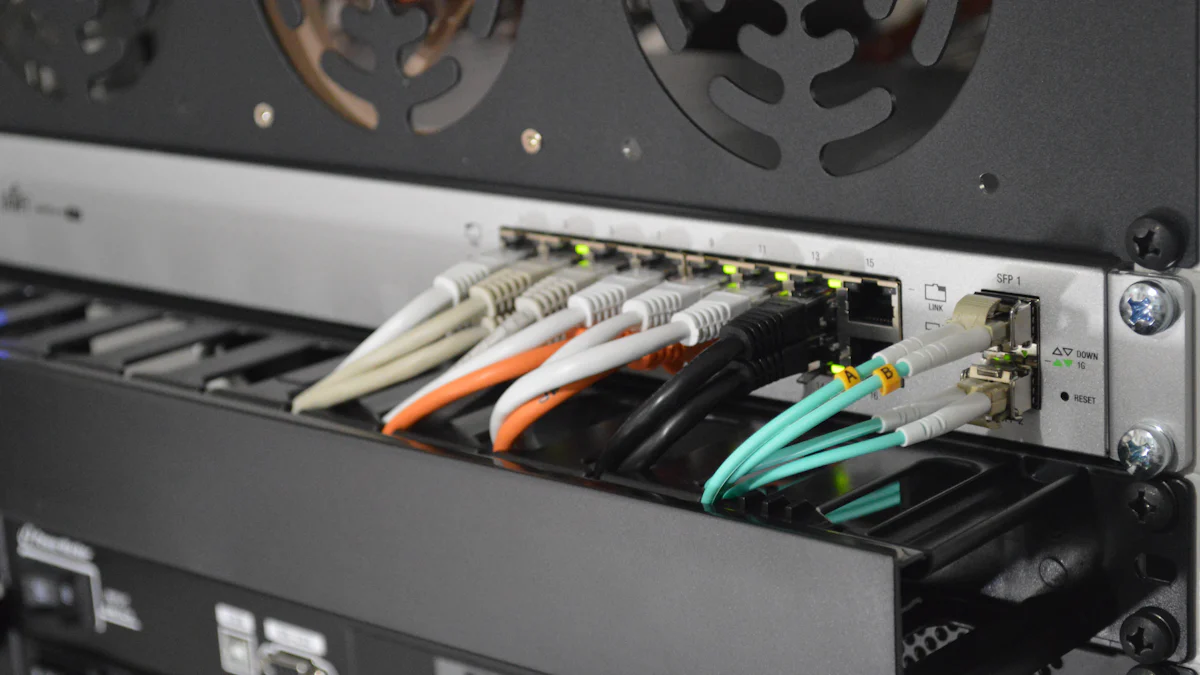What Are PoE Switches: Benefits, Applications and Recommendations

Power over Ethernet (PoE) switches revolutionize network infrastructure by providing both data and power over a single Ethernet cable. This advancement simplifies installations, reduces costs, and supports a wide range of devices, such as IP cameras, wireless access points, and IoT devices. The market for PoE switches is rapidly expanding, with a projected compound annual growth rate (CAGR) of 12.6%, expected to reach $1.2 billion by 2025. North America leads this growth trend due to high adoption rates. An active PoE switch plays a crucial role in modern networking, enabling efficient power management and device connectivity.
Understanding PoE Switches
Definition and Functionality
What is a PoE Switch?
A PoE switch serves as an Ethernet switch that delivers both power and data over a single Ethernet cable. The IEEE 802.3af standard governs this technology. This standard allows the switch to supply power to devices like IP cameras and wireless access points. The use of PoE eliminates the need for separate power cables, simplifying the installation process.
How PoE Switches Work
PoE switches utilize PSE (Power Sourcing Equipment) to transmit power through Ethernet cables. The switch detects compatible devices and supplies the necessary power. This process ensures safe and efficient power delivery. The switch can manage multiple devices simultaneously, enhancing network performance.
Types of PoE Switches
Standard PoE Switches
Standard PoE switches comply with the IEEE 802.3af standard. These switches provide up to 15.4 watts per port. The power budget supports devices with moderate power needs. Fast Ethernet and Gigabit Ethernet options are available, catering to different data speed requirements.
Managed vs. Unmanaged PoE Switches
Managed PoE switches offer advanced features for network control. These features include VLAN support and traffic prioritization. Gigabit Managed Ethernet Switch models provide enhanced security and monitoring. Unmanaged PoE switches suit simpler networks. These switches require minimal configuration and are cost-effective.
PoE+ and PoE++ Switches
PoE+ switches adhere to the IEEE 802.3at standard. These switches deliver up to 30 watts per port. PoE++ switches follow the IEEE 802.3bt standard. These switches offer up to 60 watts per port. Both types accommodate high-power devices such as PTZ cameras. Options include Gigabit Ethernet Switch models with varying port numbers.
Product Information:
FS PoE switches include PoE+, PoE++, and various port configurations.
8-Port PoE Desktop Gigabit switch provides a total PoE power budget of 130W.
24-port Gigabit PoE switch offers a 430-watt PoE budget.
Benefits of PoE Switches
Simplified Cabling
Reduced Installation Costs
PoE technology offers a cost-effective solution for network installations. Traditional setups require separate power and data cables, which increases expenses. PoE switches eliminate this need by delivering both power and data through a single Ethernet cable. This simplification reduces the overall installation costs significantly. Businesses can save money on materials and labor by avoiding additional electrical wiring. The reduction in clutter also contributes to a cleaner and more organized workspace.
Flexibility in Device Placement
PoE switches provide unmatched flexibility in device placement. Devices no longer need to be near power outlets. This advantage allows for strategic positioning of devices like IP cameras and wireless access points. Optimal placement enhances network coverage and performance. Businesses can expand their network without worrying about electrical outlet availability. The flexibility offered by PoE technology supports innovative and efficient network designs.
Enhanced Network Management
Centralized Power Management
Centralized Power Management becomes feasible with PoE switches. Network administrators can control power delivery from a central location. This capability simplifies monitoring and managing power usage across the network. Administrators can prioritize power for critical devices, ensuring uninterrupted operation. Centralized management also aids in identifying and resolving power-related issues quickly. This feature enhances the reliability and efficiency of the network infrastructure.
Improved Network Efficiency
PoE switches contribute to improved network efficiency. The integration of power and data transmission streamlines network operations. Efficient power delivery reduces energy consumption, leading to cost savings over time. PoE technology supports better-designed electrical safety features, minimizing risks. The ability to manage power effectively enhances the overall performance of the network. Businesses benefit from a robust and efficient network infrastructure that supports growth and innovation.
Applications of PoE Switches

Security and Surveillance
IP Cameras
PoE switches play a vital role in security systems by powering IP cameras. These cameras require both data and power for operation. PoE technology simplifies the installation process by using a single Ethernet cable. This setup reduces costs and enhances efficiency. Companies like Akros Silicon have contributed to advancements in PoE technology, making it more reliable for surveillance applications. The use of PoE ensures consistent power delivery, which is crucial for maintaining security systems.
Access Control Systems
Access control systems benefit from PoE technology as well. These systems manage entry points in buildings and require reliable power sources. PoE switches provide a unified solution for powering access control devices. The integration of PoE eliminates the need for separate power supplies. This simplification leads to cost savings and easier maintenance. The reliability of PoE technology ensures that access control systems remain operational at all times.
Communication Systems
VoIP Phones
VoIP phones rely on PoE switches for efficient operation. These phones need both power and data connectivity. PoE technology provides a seamless solution by delivering both through a single Ethernet cable. This setup reduces clutter and simplifies installations. The use of PoE in communication systems enhances flexibility in device placement. Businesses can position VoIP phones strategically without worrying about power outlets.
Intercom Systems
Intercom systems also benefit from PoE technology. These systems require consistent power and data transmission. PoE switches offer a reliable solution by integrating both into one cable. The use of PoE ensures uninterrupted communication within buildings. This technology supports the deployment of intercom systems in various locations. The flexibility offered by PoE allows for innovative designs in communication networks.
Wireless Networking
Wireless Access Points
Wireless access points (WAPs) depend on PoE switches for optimal performance. These devices need both power and data to function effectively. PoE technology simplifies the deployment of WAPs by using a single Ethernet cable. This approach reduces installation costs and enhances network coverage. The flexibility of PoE allows for strategic placement of WAPs, improving wireless connectivity. Companies like Cisco Systems have integrated PoE technology into their networking solutions, enhancing the capabilities of wireless networks.
IoT Devices
IoT devices benefit significantly from PoE technology. These devices often require power and data connectivity in remote locations. PoE switches provide a practical solution by delivering both through one cable. The use of PoE simplifies the deployment of IoT devices, reducing costs and complexity. This technology supports the growth of IoT networks by enabling efficient power management. The integration of PoE into IoT systems enhances their reliability and performance.
Selecting the Right PoE Switch
Choosing the right PoE Switch involves several key considerations. The PoE Switch Selection Process ensures that the network infrastructure meets current and future needs. A well-chosen switch enhances network performance and reliability.
Considerations for Selection
Power Requirements
Understanding power requirements is crucial in the PoE Switch Selection Process. Different devices have varying power needs. For instance, IP cameras and VoIP phones require specific wattage levels. PoE Power Budget plays a significant role here. The PoE Power Budget determines how many devices a switch can support simultaneously. Ethernet cables support PoE by delivering both data and power efficiently. Deploying PoE Switches with an adequate PoE Power Budget ensures uninterrupted operation.
Port Density
Port density refers to the number of available ports on a PoE Switch. High port density allows for more device connections. Businesses should assess their current and future device needs. Ethernet switches provide Gigabit connectivity options for high-speed data transfer. Gigabit Ethernet enhances network performance, especially in environments with heavy data traffic. Selecting a switch with sufficient ports supports network expansion and scalability.
Network Environment
The network environment influences the choice of a PoE Switch. Factors such as location, temperature, and humidity affect switch performance. Ethernet cables must withstand environmental conditions to ensure reliability. Ethernet offers owners flexibility in network design and device placement. Understanding the network environment helps in selecting a switch that meets specific operational demands.
Potential Limitations
Distance Limitations
Distance limitations impact the effectiveness of PoE technology. Ethernet cables typically support data transmission up to 100 meters. Beyond this distance, signal degradation may occur. Deploying PoE Switches within optimal range ensures efficient power and data delivery. Businesses should plan network layouts to minimize distance issues.
Power Budget Constraints
PoE Power Budget constraints limit the number of devices a switch can support. Each device consumes a portion of the PoE Power Budget. Exceeding the budget leads to power shortages and network disruptions. Careful planning and assessment of power needs prevent these issues. PoE Power ConsiderationsPoE Switch selection involves balancing power demands and budget constraints.
Selecting the right PoE Switch requires careful evaluation of power needs, port density, and network environment. Addressing potential limitations ensures a robust and efficient network infrastructure. Courtesy of Dreamstime, businesses can enhance their networks by making informed choices.
FAQs about PoE Switches
Common Questions
Can PoE Switches Damage Devices?
PoE switches provide power and data through Ethernet cables. Concerns often arise regarding potential damage to connected devices. The IEEE 802.3af standard governs PoE technology. This standard ensures safe power delivery. PoE switches detect compatible devices before supplying power. This detection prevents overloading or damaging devices. Network administrators should ensure that devices comply with PoE standards. Compatibility checks safeguard against potential issues.
How to Troubleshoot PoE Switch Issues?
Network engineers frequently encounter common PoE switch issues. Insufficient power can disrupt device operation. Administrators should verify the PoE power budget. Each device consumes a portion of this budget. Exceeding the budget leads to power shortages. Data connectivity issues may also arise. Ethernet cables must remain intact for optimal performance. Regular inspections can identify damaged cables. Overheating poses another challenge. Proper ventilation reduces overheating risks. Configuration optimization enhances performance and security. Administrators should regularly update firmware. Updates address potential vulnerabilities.
PoE switches revolutionize network infrastructure by delivering power and data through a single Ethernet cable. This technology simplifies installations and reduces costs for businesses. Advantech leads in adapting smart building tech with PoE solutions. Building managers benefit from centralized power management, enhancing network efficiency. Businesses gain flexibility in device placement, supporting growth and innovation. Embracing smart technology, like Bluetooth with smart building systems, ensures seamless integration. Cicero says smart buildings thrive with PoE. Community networks flourish with these advancements. PoE technology proves essential for modern networking, offering cost-effective and energy-efficient solutions.